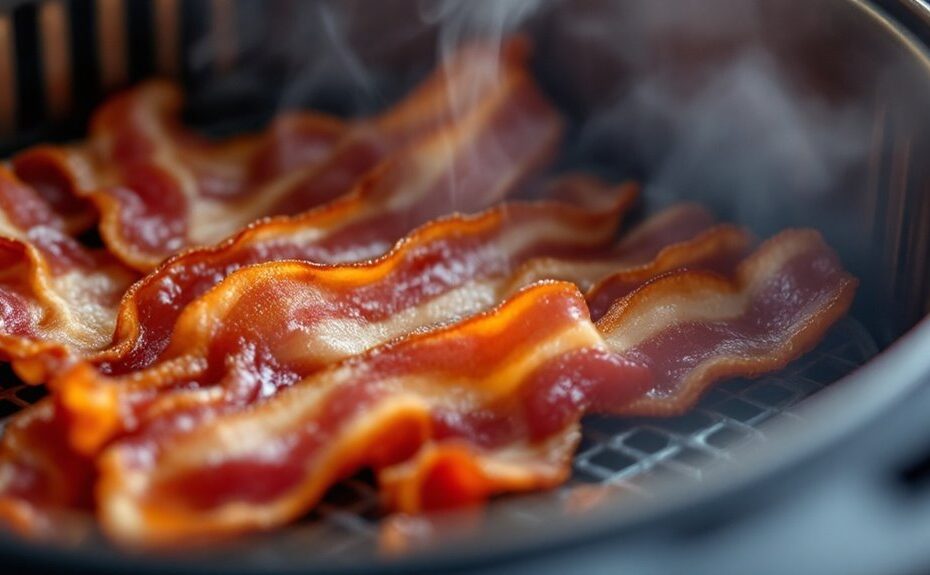Did you know that air fryers can reduce the fat content in bacon by up to 50% compared to traditional frying methods? To achieve perfectly crispy bacon, you'll need to master a few key steps, from preheating your air fryer to arranging the strips just right. But timing and temperature are essential—get them wrong, and you might end up with chewy or burnt results. The secret lies in balancing these elements while keeping an eye on the bacon's transformation. Curious about the exact process? There's more to it than you might think.
Key Takeaways
- Preheat the air fryer to 400°F and arrange bacon in a single layer without overlapping for even cooking and crispiness.
- Cook bacon at 375°F for 8-12 minutes, flipping halfway through, and monitor closely to avoid overcooking or burning.
- Use thick-cut or center-cut bacon for better texture and avoid thin-cut or pre-cooked varieties that may not crisp well.
- Drain grease using the drip tray and blot bacon with paper towels after cooking to enhance crispiness and reduce oiliness.
- Let bacon cool on a rack or paper towels for 2-3 minutes to maintain crispiness before serving or storing.
Choosing the Right Bacon for Air Frying
When selecting bacon for air frying, opt for thick-cut varieties as they hold up better to the high heat and circulating air. The bacon thickness plays a vital role in achieving the perfect balance of crispiness and tenderness. Thin-cut bacon tends to overcook quickly, becoming brittle or burnt, while thick-cut slices retain their texture and develop a satisfying crunch. For the best results, choose a bacon type that's minimally processed and free of excessive water or additives, as these can cause splattering and uneven cooking. Center-cut bacon is an excellent choice due to its leaner profile and consistent thickness. Avoid pre-cooked or pre-seasoned options, as they don't crisp up as effectively. By prioritizing bacon thickness and type, you'll set the foundation for perfectly air-fried bacon.
Preheating Your Air Fryer for Best Results
To guarantee your bacon cooks evenly and achieves the ideal crispiness, preheating your air fryer is an essential step. Set your air fryer to 400°F, the perfect temperature for crispy bacon, and allow it to preheat for 3-5 minutes. This preheat duration makes certain the cooking chamber reaches the right temperature, preventing uneven cooking or soggy results. Avoid skipping this step, as starting with a cold air fryer can lead to inconsistent texture. Double-check your air fryer's temperature settings, as some models may vary slightly. Preheating also reduces overall cooking time, helping you achieve perfectly crisp bacon faster. By taking this simple but critical step, you'll set the stage for evenly cooked, golden-brown bacon every time.
Arranging Bacon Strips in the Air Fryer Basket
Once your air fryer is preheated, carefully arrange the bacon strips in a single layer in the basket, making sure they don't overlap. Proper basket spacing is vital for even cooking and crispiness. Leave a small gap between each strip to allow hot air to circulate freely, preventing soggy spots. For ideal strip alignment, lay the bacon flat, avoiding folds or curls that can trap grease. If your basket is small, you may need to cook in batches to maintain consistent results. Overcrowding the basket disrupts airflow and leads to unevenly cooked bacon. Take your time positioning each strip to maximize efficiency and achieve the desired texture. Proper arrangement guarantees every piece cooks uniformly, delivering perfectly crispy bacon every time.
Setting the Correct Temperature and Time
After arranging the bacon strips in the air fryer basket, set the temperature to 375°F (190°C) for ideal crispiness. This temperature guarantees the fat renders properly while the bacon becomes golden and crunchy. Cook for 8-12 minutes, depending on thickness and desired doneness. Thicker cuts may require slight temperature adjustments, such as reducing to 360°F (182°C) to prevent burning. For thinner bacon, stick to 375°F but monitor closely to avoid overcooking. Time variations are normal; check every 2-3 minutes after the 8-minute mark. Use tongs to flip the strips halfway through for even cooking. Adjust the time or temperature slightly if your air fryer model runs hotter or cooler. Precision in these settings assures perfectly crispy bacon every time.
Avoiding Overcrowding for Even Cooking
When cooking bacon in an air fryer, you'll want to make sure the strips aren't overlapping or crowded in the basket. Proper bacon spacing secures even cooking and crispiness. Overcrowding restricts air circulation, which can lead to unevenly cooked bacon, with some pieces remaining limp while others burn. Arrange the strips in a single layer, leaving a small gap between each piece to allow hot air to flow freely. If your air fryer basket is small, cook the bacon in batches rather than forcing all the strips in at once. This approach maximizes the appliance's efficiency and assures consistent results. Remember, adequate spacing is key to achieving perfectly crispy bacon, as it allows the heat to distribute evenly across every strip.
Flipping Bacon Midway for Uniform Crispiness
To guarantee your bacon cooks evenly and achieves a uniform crispiness, flip the strips halfway through the cooking process. This flipping frequency secures both sides crisp up uniformly, preventing one side from becoming overly done while the other remains undercooked. Adjust the timing based on bacon thickness; thicker cuts may require slightly longer intervals between flips to make certain thorough cooking. Use tongs to carefully turn each strip, avoiding splatters or tearing. Midway flipping also helps redistribute heat, promoting consistent texture across all pieces. For best results, check the bacon's progress at the halfway mark and flip only once to maintain efficiency. Proper flipping guarantees every bite delivers the perfect balance of crunch and tenderness, making your air-fried bacon a standout dish.
Draining Excess Grease During Cooking
To manage excess grease while cooking bacon in an air fryer, make sure you're using the drip tray to collect fat as it renders. Tilt the basket slightly after cooking to let any remaining grease drain into the tray. For extra crispiness, blot the bacon with paper towels before serving to remove lingering oil.
Use a Drip Tray
Using a drip tray is essential for preventing excess grease buildup while cooking bacon in an air fryer. The drip tray benefits include keeping your air fryer clean and guaranteeing the bacon cooks evenly without sitting in pooled grease. Place the tray beneath the bacon to collect rendered fat as it cooks, which also reduces smoke and prevents flare-ups. For effective grease collection tips, make sure the tray is properly positioned and check it periodically to avoid overflow. If your air fryer doesn't come with a drip tray, use a heat-safe dish or aluminum foil to create one. This simple step not only enhances the crispiness of your bacon but also simplifies cleanup, making your cooking process more efficient and mess-free.
Tilt the Basket
Tilting the basket while cooking bacon in an air fryer helps manage excess grease and improves crispiness. To achieve this, slightly elevate one side of the basket during cooking to create a basket angle that encourages grease drainage. This simple adjustment allows rendered fat to flow away from the bacon, preventing it from sitting in pooled grease, which can lead to uneven cooking or sogginess. Use a heat-safe utensil or a small prop to maintain the angle, ensuring the bacon remains exposed to consistent airflow. By controlling grease drainage, you'll enhance the texture and flavor of your bacon, making it evenly crispy. Monitor the process to avoid over-tilting, which could cause the bacon to slide or cook unevenly. This technique maximizes efficiency and delivers superior results.
Blot With Paper Towels
While cooking bacon in an air fryer, you'll want to blot it with paper towels to remove excess grease and secure ideal crispiness. After cooking, transfer the bacon to a plate lined with paper towels. Press another towel gently on top to absorb residual grease. This step confirms effective grease absorption, preventing sogginess and enhancing texture. Moisture removal is critical for achieving that perfect crunch, as lingering grease can soften the bacon over time. Avoid pressing too hard, which might flatten the strips. Replace the towels if they become saturated to maintain efficiency. Blotting not only improves crispiness but also reduces greasiness, making the bacon more enjoyable. This simple yet essential technique verifies your air-fried bacon stays irresistibly crispy and flavorful.
Checking for Desired Crispiness Levels
To guarantee your bacon reaches the perfect crispiness, you'll need to monitor it closely during the final minutes of cooking. Begin crispiness testing by carefully lifting a slice with tongs to assess its texture. Look for a golden-brown color and listen for a faint crackling sound, which indicates it's nearing the desired level. For texture evaluation, gently press the bacon with the tongs—it should feel firm but not brittle. If it bends too easily, it needs more time. Avoid overcooking, as bacon can quickly shift from crispy to burnt. Check every 1-2 minutes to confirm precision, as air fryers can vary in heat distribution. Adjust cooking time based on your preference, whether you prefer slightly chewy or fully crispy bacon.
Removing and Cooling Bacon Properly
Once the bacon reaches your desired crispiness, immediately remove it from the air fryer using tongs to prevent overcooking. Transfer the bacon to a plate lined with paper towels or place it on cooling racks to allow excess grease to drain. Cooling racks elevate the bacon, ensuring air circulates evenly and prevents sogginess. Let the bacon rest for 2-3 minutes to achieve the perfect texture—crispy yet tender. For bacon storage, allow it to cool completely before transferring it to an airtight container or resealable bag. If storing for later use, refrigerate it promptly to maintain freshness. Proper cooling and storage preserve the bacon's crispiness and flavor, ensuring it's ready to enjoy whenever you need it.
Cleaning Your Air Fryer After Use
After cooking bacon in your air fryer, cleaning it promptly secures it stays in top condition and prevents lingering grease or odors. Start by unplugging the appliance and letting it cool. Remove the basket and tray, then pour collected grease into a heatproof container for proper grease disposal. Use warm, soapy water and a non-abrasive sponge or soft-bristle brush as your cleaning tools to scrub the basket, tray, and any removable parts. Wipe the interior with a damp cloth, avoiding the heating element. For stubborn residue, soak parts briefly before scrubbing. Dry all components thoroughly before reassembling. Regular cleaning assures your air fryer performs efficiently and extends its lifespan. Always refer to the manufacturer's instructions for specific care guidelines.
Disclosure: As an Amazon Associate, I earn from qualifying purchases.



